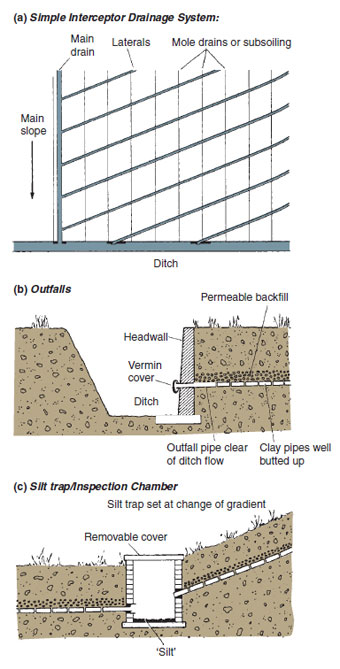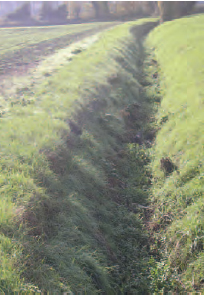Drainage
Content
As gravitational (excess) water leaves the macropores, the air that takes its place ensures that the root zone is replenished with ‘fresh air’ . Horticultural soils should return to at least 10 per cent air capacity in the top half metre within one day of being saturated (see porosity). Some soils, notably those over chalk or gravel, are naturally free draining. However, many have underlying materials which are impermeable or only slowly permeable to water, and in such cases artificial drainage, sometimes referred to as field drainage or under drainage, is put in to carry away the gravitational water (see Figure 19.3). This helps the soil to restore air content rapidly without reducing the available water content. Well-drained soils are those that are rarely saturated within the upper 90 cm except during or immediately after heavy rain. Uniform brown, red, or yellow colours indicate an aerobic soil, i.e. a soil in which oxygen is available. Poorly-drained soils are saturated within the upper 60 cm for at least half the year and are predominantly grey which is typical of anaerobic soil conditions. Between these extremes, imperfectly drained soils are those that are saturated in the top 60 cm for several months each year. These soils tend to have less bright colours than well-drained soil; grey and ochre colours are usually seen at 450 mm giving a characteristic rusty mottled appearance (see Figure 17.7). Symptoms of poor drainage Symptoms of poor drainage include:
Soil colours show the history of water-logging in the soil. Whereas free drainage is indicated by uniform red, brown or yellow soil throughout the subsoil, the iron oxide which gives soil these colours in the presence of oxygen is reduced to grey or blue forms in anaerobic conditions, i.e. when no oxygen is present. Zones of soil that are saturated for prolonged periods have a dull grey appearance, referred to as gleying (see Figure 17.7). Reliance on colour alone as an indication of drainage conditions is not recommended, because it persists for a long time after efficient drainage is established (see also soil types p301–3). Structural damage, whether caused by water (see stability), machinery (see cultivation), or by accumulations of iron (see natural pans), is an obstruction to water fl ow in the soil profile. Pans or platy structures near the surface can be broken with cultivating equipment on arable land or spiking on grassland; but subsoiling is used to burst those deeper in the soil. If water cannot soak away from well-structured rooting zones, artificial drainage is required. Artificial drainage The low permeability of many subsoils, which create a perched water table, is the major reason for artificial drainage in horticultural soils. Clay, clay loam and silty clays, when wetted, become almost impermeable as the clay swells and the cracks close; clay is ‘puddled’ to form a liner for ponds. This ‘top water problem’ is dealt with by putting in pipes to intercept the trapped gravitational water. Straight lines of pipes are placed at an even gradient from the highest point to the outfall in a ditch or main drain (see Figure 19.4). The pipes are laid below cultivation depth in a series of parallel lines across the slope to the headland of the area to be drained. Where a valley or the lower areas lie within the area to be drained, a herringbone pattern is used.
The pipes are made of clay or plastic. The diameter of the pipe depends on the gradient available and the amount of water to be carried when wet conditions prevail. Tiles (clayware) are usually 300 mm pipes either 75 mm or 100 mm in diameter (see Figure 19.1). These lead into a ditch or a larger main drain. The tiles are butted tightly together to allow entry of water, but not soil particles. It is recommended that they are covered with permeable fill, usually stones or clinker, to improve water movement into the drains. Plastic pipes consist of very long lengths of pipe perforated by many small holes and usually covered with a rough felt to keep out soil particles. An outlet into a ditch is very vulnerable to damage and so it should consist of a strong, long pipe set fl ush in a concrete or brick headwall so that it is neither dislodged by erosion in the ditch nor by people using it as a foothold. Outlet pipes should be glazed to prevent frost damage. Vermin traps should be fitted to prevent pipes being blocked by nests or dead animals (see Figure 19.4). Mole drainage is very much cheaper than pipe drainage. A mole plough draws a 75 mm ‘bullet’, followed by a 100 mm plug, through the soil at a depth of 500–750 mm from a ditch up the slope of a field or across a pipe drain system with permeable backfill (see Figure 19.4). The soil should be plastic at the working depth so that a tunnel to carry water is created. The soil above should be drier so that some cracks are produced as the implement is drawn slowly along. These cracks improve the soil structure and conduct water to the mole drain. Sandy and stony areas are unsuitable because tunnels are not properly formed or collapse as water fl ows. Tunnels drawn in clay soils can remain useful for 10–15 years, but in wetter areas their useful life may be nearer 5 or even as little as 2 years. Sandslitting is used on sports grounds to remove water from the surface as quickly as possible. It involves cutting narrow trenches at frequent intervals in the soil and infilling with carefully graded sand that conducts water from surface to a free draining zone under the playing surface. French drains can be placed around impermeable surfaces, such as concrete hard standings and patios, to intercept the run-off.
Maintenance of drainage systems Artificial drainage is very expensive to install and must be serviced to ensure that the investment is not wasted. Ditches need regular attention because they are open to the elements (see Figure 19.5). Weed growth should be controlled; rubbish cleared out and collapsed banks repaired, because obstructions lead to silting up or undercutting of the bank. The design of the ditches depends on the soil type and should be maintained when being repaired. The batter (the slope of the sides) on sandy soils has to be less steep than on clays. Drain outlets are a particularly vulnerable part of the drainage system, especially if not set into a headwall. They should be marked with a stake (holly trees were traditionally used in some areas) and inspected regularly after the soil returns to field capacity. Blockages should be cleared with rods and vermin traps refitted where appropriate. Silt traps need to be cleaned out regularly to prevent accumulated soil being carried into the pipes. Wet patches in the field indicate where a blockage has occurred. The pipe should be exposed and the cause of the obstruction removed. Silted-up pipes can be rodded, broken sections replaced, or dislodged pipes realigned. At all times it should be remembered that the drains only carry away water that reaches the pipes. Every effort must be made to maintain good soil permeability and to avoid compaction problems. Subsoilers should be used to remedy subsoil structural problems. Once drainage has been installed the soil dries more quickly, leading to better soil structure because cracks appear more extensively and for longer periods. Deeper layers of the soil are dried out as roots explore the improved root environment, which adds to the improving cycle. Groundwater (‘bottom water’) problems occur where the water table is too high and drains at the desired depth are of no use, because there is nowhere low enough to discharge the water. An artificially low water table can be created by pumping water out of the ditches up into a network of waterways. A line of windmills that provided the required energy was a familiar sight in lowland areas such as the Fens, where such land reclamation was undertaken. Goundwater problems are a common feature of many gardens where attempts to introduce drainage systems are thwarted by there being nowhere suitable (or legal) to discharge the water. |
|||||||||||||||||||||||||






